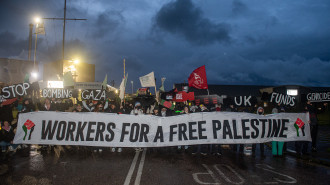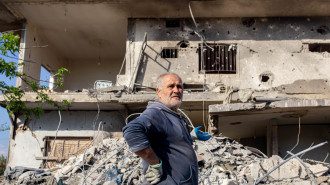With Al-Qassam and Al-Quds Brigades, four other armed Palestinian factions are fighting Israel in Gaza
To support Hamas and the Palestinian Islamic Jihad (PIJ) and despite any ideological or political differences, thousands of fighters from four other Palestinian factions have been fighting against the Israeli occupation forces in Gaza since last October.
As well as al-Qassam Brigades — the armed wing of Hamas — and al-Quds Brigades — the armed wing of the PIJ and second-strongest armed faction in Gaza — these other armed factions fighters are actively participating in attacks on invading Israeli ground troops, launching rockets at the Israeli towns and even holding some of the Israelis that were captured last October, according to a senior Palestinian official, who preferred to remain anonymous.
The following will outline the most important armed factions involved. These factions are smaller in number of fighters and possess fewer capabilities than Hamas' Al-Qassam Brigades and PIJ's Al-Quds Brigades:
Al-Aqsa Martyrs Brigades
Despite being the main political rival to Hamas, fighters in Fatah's al-Aqsa Martyrs Brigades in Gaza have joined "to confront the Israeli occupation forces in the Gaza Strip and carry out qualitative military operations in support of both Hamas and Islamic Jihad fighters", noted senior Palestinian officials.
In separate interviews with The New Arab, Fatah officials who preferred to be anonymous said, "Fatah has never laid down its weapons but used them sparingly and engaged in military action in a way that suits the needs of our Palestinian people."
"Currently, we are all facing the same catastrophe(...) The Israeli enemy does not differentiate between a Palestinian who follows Fatah and another who belongs to Hamas. For him, everyone is a target. The Israelis want to eradicate the Palestinian people, without exception," the officials said.
"It is our duty to have our say and our presence in the field because we are defending Palestinian existence, our cause, and our people, far from any political differences," the official added.
Three battalions within the Fatah movement are actively in combat with the Israeli army, led by the Al-Aqsa Martyrs Brigades, the official military wing of Fatah: the Al-Aqsa Martyrs Brigades, the Nidal Al-Amoudi Brigade, and the Mahmoud Masoud Brigade, in addition to the Al-Ahrar Movement, headed by Khaled Abu Hilal, a former Fatah leader killed during an Israeli raid on his home last November.
According to officials in the Al-Aqsa Martyrs Brigades, the number of fighters operating under its banner is a few thousand. The officials said that fighters received military training inside the Gaza Strip, where they possess hundreds of homemade rockets and other weaponry from both Hamas and Islamic Jihad, in addition to a sufficient number of weapons and Kalashnikovs.
These Fatah fighters have participated in bombing concentrations of the Israeli army in Gaza, direct fire-fights with Israeli ground troops, and claimed to have sniped and killed several Israeli soldiers.
Palestinian President Mahmoud Abbas publicly denies the existence of these armed Fatah-affiliated groups, especially after he had vowed to dismantle all "armed militias" following his adoption of a policy of strictly pursuing an unarmed popular struggle against the Israeli occupation.
However, according to fighters within the Al-Aqsa Martyrs Brigades, they are still receiving financial support from "Fatah leaders who were living in Gaza and part of them are still in the occupied West Bank who believe that armed struggle is the only means by which the Palestinian people can obtain their national and human rights."
The Fatah-affiliated armed brigades are considered the weakest of these groups; they were the strongest during the second intifada in 2000.
Al-Nasser Salah al-Din Brigades
Al-Nasser Salah al-Din Brigades is the armed wing of the Popular Resistance Committees. This Islamic-oriented group believes that only armed struggle is capable of liberating Palestine and preventing Israel from succeeding in its colonial ambitions in the Palestinian territories.
Thousands of Palestinian fighters belong to the Popular Resistance Committees. According to Palestinian officials, Al-Nasser Brigades fighters played an important role in attacking Israeli army concentrations in Gaza by targeting them in joint operations with Islamic Jihad and the Al-Aqsa Martyrs Brigades with several homemade rockets and close-range shells.
Abu Ali Mustafa Brigades
Abu Ali Mustafa Brigades, the military wing of the Popular Front for the Liberation of Palestine (PFLP), was formed as part of the Popular Resistance Forces in 2000. It was named after the party's former Secretary-General, Abu Ali Mustafa, whom Israel assassinated in 2001.
It is currently considered the fifth-strongest force and includes hundreds of fighters in Gaza and the occupied West Bank. About 2,000 of its fighters received local military training and are known to excel at firing short- and long-range missiles. Its most extensive successful operation to date was the assassination of the former Israeli Minister of Tourism, Rehavam Ze'evi, in 2001.
The Abu Ali Mustafa Brigades, the Al-Aqsa Martyrs Brigades and the Jerusalem Brigades participated in joint operations to defend against invading Israeli forces.
The Palestinian National Resistance Brigades
The Palestinian National Resistance Brigades is the military wing of the Democratic Front for the Liberation of Palestine (DFLP). Like others, it was formed during the Second Intifada in 2000 and has an armed presence in Gaza, the occupied West Bank and Jerusalem and has been able to carry out repeated raids on illegal Israeli settlements and outposts in the occupied West Bank and Gaza.
It is a Communist national liberation movement and participated in the Hamas-led surprise attack on Israeli military bases and civilian settlements within and around the Gaza envelope last October.
According to statements by its officials, a number of its fighters were involved in the attack, and others are supporting in guarding the Israeli captives in the Gaza Strip.
Additionally, its fighters are regularly in active combat against Israeli forces in the Gaza Strip.
"Although the Al-Qassam Brigades and the Al-Quds Brigades are the strongest on the ground, fighters from other factions joining the fight has created a balance not only on the field but also politically, especially since Israel has always bragged since the beginning of its war that it is only fighting Hamas, which it described as similar to ISIS, to justify its crimes against all the Palestinian people," Wasef Erekat, a Ramallah-based Palestinian military expert, told TNA.
"The presence of diversity in the fighters' ideological and political backgrounds and tactics in confronting the Israeli occupation prevents Israel from being able to commit even more crimes against the Palestinians and debunks their claim that they are only fighting 'extremists' and Hamas," Erekat said.
"The Palestinian resistance factions have succeeded in thwarting Israel's plan. They affirm that the conflict with Israel is a national struggle, a conflict against an occupier who stole land and killed its people," he added.
Erekat further noted that the Palestinian factions have shifted from defensive tactics during previous Israeli wars in Gaza to assertive tactics in this current battle. "They also developed their performance and methods and are managing the current battles with great professionalism, especially since they have accumulated military achievements and field experience," he said.
The 'day after'
"Israel and the United States have long tried to stamp out Palestinian armed resistance and hold Hamas fully responsible for the 7 October attack. They ignored the violations against Palestinians in the occupied West Bank, Jerusalem, and Gaza for decades and considered the 7 October attack a 'crime against humanity' and mobilised international and, unfortunately, some of the Arab opinion against Hamas," remarked Iyad al-Qarra, a Gaza-based Palestinian analyst.
"But, the armed factions affiliated with the political Left prevented this attempt and stressed that Palestinian weapons would remain present as long as there was Israeli occupation".
"The presence of the armed resistance with its various brigades reaffirms that the Palestinian cause is one of land and its people, and the only solution is the end of the Israeli occupation and colonisation in all its forms," he added.
"This requires a national program to confront the consequences of this barbaric war on the people of Palestine with a unified strategy that represents the Palestine cause as a national liberation issue," al-Qarra stressed. "Even after this war, the armed resistance will not end (...), but I believe that there will be deep introspection in the near future and a new formation of resistance factions to ensure protection for our people and confront the Israeli occupation, whatever the cost."
![Palestinian factions in Lebanon [AFP] Palestinian factions in Lebanon [AFP]](/sites/default/files/styles/image_345x195/public/media/images/1DBF23DC-2DD7-4E55-B2A7-6E7F9861EB25.jpg?h=d1cb525d&itok=XKSvPUjW)




 Follow the Middle East's top stories in English at The New Arab on Google News
Follow the Middle East's top stories in English at The New Arab on Google News


